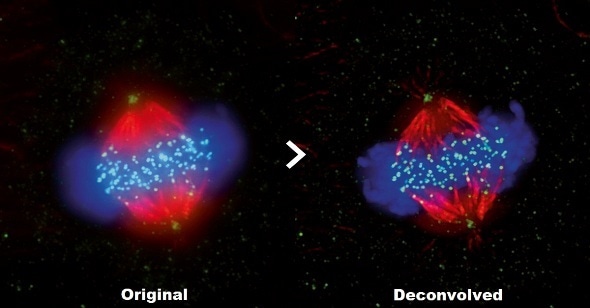Helping drive research forward at a faster rate, Olympus cellSens 2.1 speeds up image analysis with improved capabilities for flexible camera and microscope control. The updates ensure cellSens remains a powerful tool covering a wide range of applications and benefiting routine microscopy users as well as advanced imaging facilities.

A fluorescent image shown before (left) and after (right) deconvolution with the image deconvolution module in cellSens 2.1.
With expanded imaging capabilities, Olympus has launched version 2.1 of its imaging platform cellSens. Enabling researchers to create clean and detailed images in less time, this latest version of cellSens delivers faster deconvolution and improved feature sets across all software levels.
Reaffirming cellSens’ position as an advanced, comprehensive solution for imaging facilities, cellSens Dimension and Standard now feature fully integrated multi-channel acquisition and support for the latest high-end devices. The capabilities of cellSens Entry have also been expanded so that all cellSens users can now manage encoded devices, perform measurements and export the results to Excel. Advanced imaging capabilities such as panoramic and extended depth-of-focus imaging are now also available to all users.
Important time savings can now be obtained if the application requires the creation of de-blurred fluorescence images. Deconvolution calculations exploit the processing power of modern graphics cards to obtain clean and precise images up to 7 times faster than before. Productivity and interactivity are greatly enhanced as, for example, a deconvolved image can now be obtained in 10 seconds instead of in one minute.
In addition, in order to facilitate the integration of cellSens into advanced imaging facilities even further, export functions have been made more flexible and powerful. Images are easily exported from cellSens in different file formats, including Open Microscopy Environment (OME), as single files or multiple files split according to external application need.
These advances in speed, functionality and compatibility make cellSens well suited for both routine and advanced research applications – underlining Olympus’ commitment to providing a flexible, user-friendly software platform that supports life science researchers everywhere.